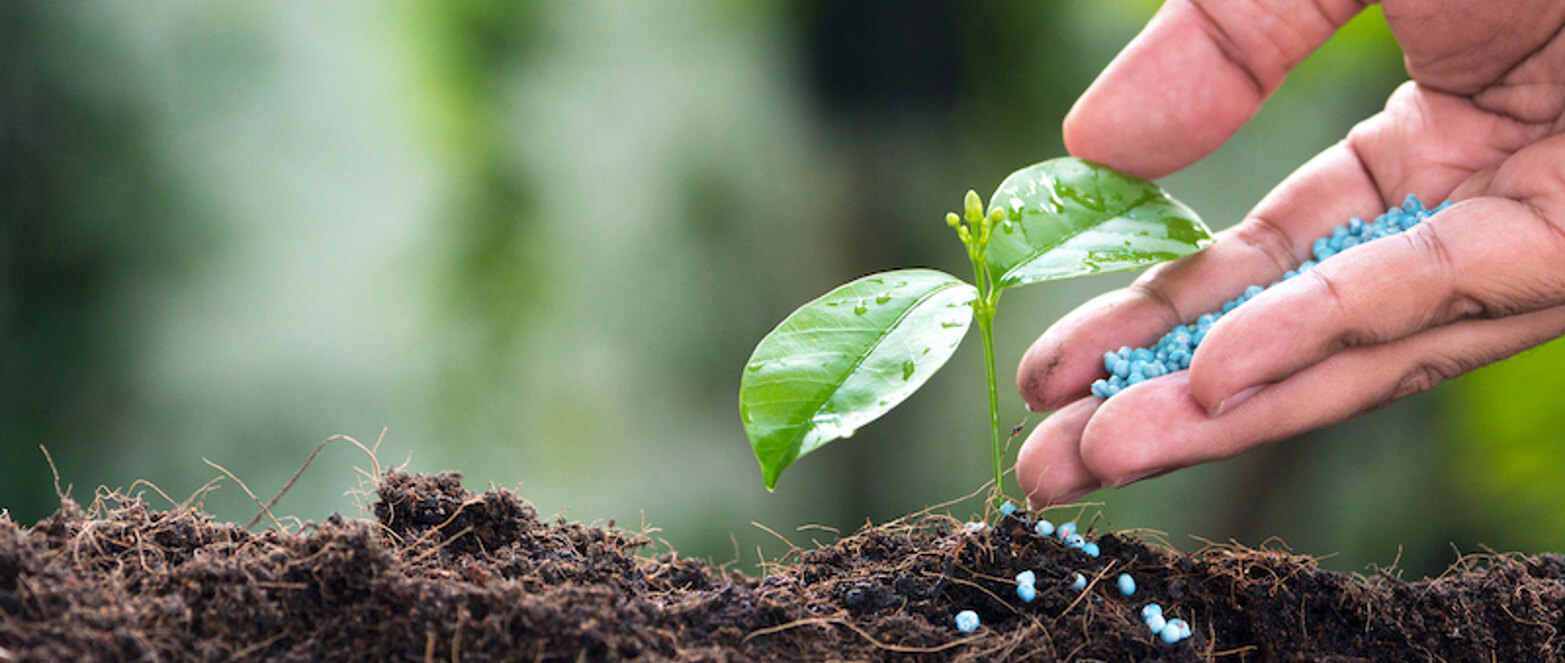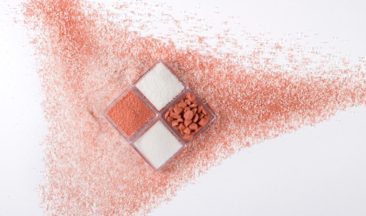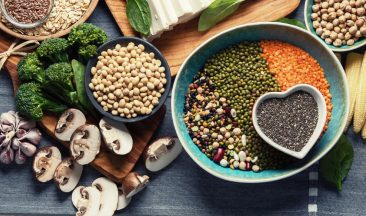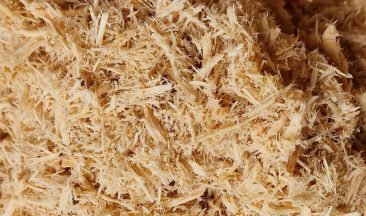Nineteenth-century economists and social scientists worked feverishly to prevent the end of mankind. What stirred them on was the theory, proposed by the British economist Thomas Malthus, that the world would soon run out of food.
Malthus based this theory on his belief that the population was increasing exponentially while its food supply increased arithmetically. Thus, barring wars, pandemics, “moral restraint” (i.e., abstinence), or other forms of “population control”, there would soon not be enough food to sustain human life.
And yet, we are still here. Why?
Possibly because Malthus failed to take technology into account. If he had paid attention to the agricultural revolution in his native England, he would have seen many changes taking place to minimize threats to food stability.
The land was being reallocated to make farms more compact and, thus, more efficient. Farmers were being bombarded with technical improvements–new machinery, better drainage systems, new crops, and new methods of crop rotation—so they could grow food more efficiently. And agronomists were starting to investigate the most basic factor in the “feast-vs-famine” equation: fertilizer.
Technical innovation, automation, and the availability of a wide variety of fertilizers continue to transform traditional farming into an industry.
What are fertilizers?
Fertilizer is any substance that is added to soil to supply nutrients to plants. Ideally, fertilizer should provide three nutrients that are essential for optimal plant growth: nitrogen (N), phosphorus (P), and potassium (K).
When used judiciously in combination with other effective agricultural practices– adequate irrigation, quality seeds, soil fertility management, etc.—fertilizer helps produce a successful yield. For maximum effect, fertilizer should be free-flowing, made of hard granules, consistent in particle size, easy to spread, rich in many nutrients, easy to dissolve in moist soil, and free from undesirable contaminants.
A brief history of fertilizers
Since the beginning of time, farmers have seen crop yields diminish in the land that is used continuously and varies in quality in different types of soil. They often added materials to the soil to boost its fertility.
Manure became a common “additive”, being readily available as herds grazed over farmland. Other additives have included wood ash, gypsum, and guano (bird excrement).
Unfortunately, the results from simply plowing such additives into the earth were not always predictable, being subject to the weather, soil conditions, predators, and other factors.
Fertilizer effectiveness received a boost during the 1840s when German chemist Justus von Liebig advocated for the application of specific nutrients to the soil to improve plant growth. As he was the first person to discover that nitrogen helps grow healthier crops,
Liebig is known as the “Father of the Fertilizer Industry”. He was also able to identify the importance of phosphorus, and potassium as essential nutrients for adequate plant growth. In addition, Liebig formulated the Law of the Minimum, which describes how plant growth relies on the scarcest nutrient resource, rather than the total amount of resources available.
During the 20th century, three additional methods of enhancing the ammonia-based nitrogen content of soil were introduced:
- The Haber-Bosch process synthesizes ammonia from hydrogen and nitrogen.
- The Erling Johnson method exposes phosphate-rich rocks to nitric acid to produce both phosphoric acid and calcium nitrate, which can be used to produce either a nitrogen-based fertilizer or a compound (nitrophosphate) fertilizer.
- The Ostwald process exposes ammonia to oxygen and water in the presence of platinum to produce nitric acid
These methods were developed in response to a US food crisis in 1899 and were used successfully to combat food instability during the prolonged US drought during the 1930s that resulted in the Dust Bowl.
Ongoing research has led to the development of fertilizers that can be customized for specific types of crops under specific growing conditions to make them sturdy enough to maintain their quality and effectiveness during the roughest modes of transport and the wildest swings in the weather.
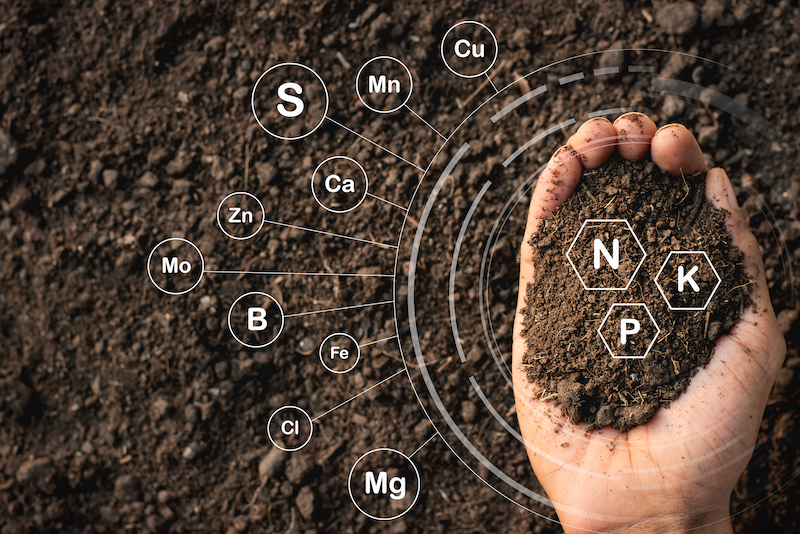
Essential nutrients for plant growth and health
Plants require 17 essential nutrients for growth: carbon (C), hydrogen (H), oxygen (O), nitrogen (N), phosphorus (P), potassium (K), sulfur (S), calcium (Ca), magnesium (Mg), boron (B), chlorine (Cl), copper (Cu), iron (Fe), manganese (Mn), molybdenum (Mo), nickel (Ni), and zinc (Zn).
Carbon, hydrogen, and oxygen are supplied by air and water. The six macronutrients– nitrogen, phosphorus, potassium, calcium, magnesium, and sulfur– are required by plants in large amounts. The rest of the elements are required in trace amounts and are known as micronutrients.
These nutrients are essential for healthy plant growth. Specifically, plants need them to complete their life cycle, i.e., for seeds to germinate and for roots, stems, leaves, and flowers to develop. There are three criteria for an element to be considered essential:
- A plant cannot complete its life cycle in the absence of the mineral element.
- The function of the element cannot be performed by another mineral element.
- The element must be directly involved in plant metabolism.
Each nutrient must be provided in its proper amount: too much manganese, for example, can cause the leaves to turn yellow and die; too much nitrogen can result in more leaves, but less fruit.
Plant nutrients should be provided in an optimum ratio and adequate amounts. This is called “Balanced Fertilization”. Continuously imbalanced fertilization (i.e., too much nitrogen and no potassium) causes depletion in soil fertility, a decrease in crop yields, poor crop quality, and diminishing profits.
Organic manure contains small amounts of N, P, and K nutrients and can not supply alone all the nutrients needed by the crops. The application of organic manure in balanced fertilization is very valuable due to micronutrient supply and improvement of the soil quality by enhancing microbiological activity and physical properties (structure, water-holding, aeration).
The best results are obtained when commercial fertilizers are applied in combination with organic manures. This is called Integrated Nutrient Management (INM). The source, mode of uptake into plants, and functions of these nutrients in plants are summarized in the table below.
TABLE: NUTRIENTS FOR FERTILIZERS
| NUTRIENT | SOURCE | FORM OF UPTAKE | MODE OF UPTAKE | MAIN FUNCTIONS IN PLANTS |
| MACRONUTRIENTS | ||||
| Carbon | Water/air | · Carbon dioxide· Bicarbonate | Open stomates | · Building plant structures |
| Oxygen | Water/air | · Water | Mass flow | · Respiration· Energy production· Plant structures |
| Hydrogen | Water/air | · Water | Mass flow | · Acidity (pH regulation)· Water retention· Synthesis of carbohydrates |
| Nitrogen | Air/soil | · Nitrate· Ammonium ions | Mass flow | · Builds proteins and chlorophyll· Cell formation |
| Phosphorus | Soil | · Dihydrogen phosphate· Phosphate | Root interception | · Cell formation· Protein synthesis· Carbohydrate and fat metabolism |
| Potassium | Soil | · Potassium ions | Mass flow | · Water regulation· Enzyme activity· Protection against harsh changes in weather· Protection against pests |
| Calcium | Soil | · Calcium ions | Mass flow | Structure of cell wall and membranes· Enzyme activity |
| Magnesium | Soil | · Magnesium ions | Mass flow | · Chlorophyll· Fat formation and metabolism |
| Sulfur | Soil | · Sulfate ions | Mass flow | · Protein, amino acid, vitamin, and oil formation |
| MICRONUTRIENTS | ||||
| Chlorine | Soil | · Chloride ions | Root interception | · Chlorophyll formation· Enzyme activity· Cellular development |
| Iron | Soil | · Iron ions | Root interception | · Enzyme development and activity |
| Zinc | Soil | · Zinc ions | Root interception | · Enzyme activity |
| Manganese | Soil | · Manganese ions | Root interception | · Enzyme activity· Pigmentation |
| Boron | Soil | · Boric acid· Borate | Root interception | · Enzyme activity |
| Copper | Soil | · Copper ions | Mass flow | · Enzyme activity |
| Molybdenum | Soil | ·Molybdenum hydroxide oxide· Molybdenum methyl cyclooctene | Mass flow | · Enzyme activity· Nitrogen fixation (legumes) |
| Nickel | Soil | Nickel ions | Plant nitrogen metabolismNitrogen fixation (legumes) |
ICL Fertilizers
The myriad of nutrients and methods of nutrient intake point to the broad array of fertilizers available today. As a world-leading fertilizer manufacturer, ICL uses state-of-the-art technology to provide farmers with the critical nutrients needed to boost productivity, health, and quality of crops.
Our portfolio includes controlled-release, fertigation, foliar, granulated NPK, potash, phosphate, Polysulphate®, and next-generation (next-gen) fertilizers among others.
Controlled Release Fertilizers (CRF) are coated fertilizer granules that release nutrients over a known period of time. They play a key role in improving yield, reducing nutrient losses, and simplifying fertilizer application. These products help regulate the nutrient levels throughout the plant’s growth cycle.
Younger plants are not harmed or stressed by excess salt levels, whereas mature plants have enough nutrients to last until the end of the growth cycle. A simple one-time application of ICL’s CRF delivers targeted nutrition that leads to uniform growth, optimum yield, and resistant plants: maximum results with minimal effort.
The benefits of ICL’s Controlled Release Fertilizers at a glance are as follows:
- Higher nutrient efficiency through reduced losses
- Higher or equal yield with less mineral input due to continual feeding
- Fewer applications = lower costs
- Better for the environment due to reduced leaching
- Enhanced crop uniformity thanks to controlled nutrition
- Greater protection against early season “salt stress”
- Enhanced crop uniformity thanks to controlled nutrition
Fertigation fertilizers are soluble fertilizers that are mixed with the irrigation water to enhance crop production. In this system, the fertilizer solution is distributed evenly in irrigation.
The availability of nutrients is very high therefore efficiency is increased. It is a highly effective and flexible tool for controlling the placement, timing, and nutrient application method. This enables precise nutrition to be applied according to the soil fertility status and growth stage of any crop.
ICL sets the standard in fertigation fertilizer technology. ICL uses PeKacid® in its formulations. The focus of this technology is the acidifying effect that produces a range of benefits:
- Enhance nutrient uptake: acidifies the soil environment, which increases the availability and uptake of P and micronutrients.
- Lower pH: reduces water pH when applied directly to hard water.
- Avoid clogging: provides acidity to neutralize and dissolve bicarbonates, thereby avoiding clogging of drippers and pipes.
Foliar fertilizers are sprayed directly on the leaves. Foliar feeding provides an excellent solution when the plant root system is not functioning optimally or nutrition via the soil is malfunctioning.
This form of feeding is ideal when nutrient uptake through the root is disturbed by factors such as overly cold or warm soils, high soil pH, high weed competition, or nematode infestation. Foliar fertilizers are also perfect for use as a preventive tool to avoid deficiencies and reduce stress situations.
ICL’s research and development team has developed some of the world’s leading and innovative foliar nutritional solutions. These state-of-the-art solutions focus on both applications for curative and preventive actions.
ICL uses unique patented technologies like M-77® and DPI to increase the efficiency of the foliar application.
Polysulphate® is a natural mineral that is mined from underneath the North Sea that contains four nutrients: sulfur, potassium, magnesium, and calcium. It is a single complex crystal, totally natural, and ready to be used straight from the ICL mine on the fields.
This natural, multi-nutrient mineral is low in chloride and crop safe, suitable for use alone or in blends and compound fertilizers. It is approved for organic agriculture.
ICL has designed the Polysulphate® family of products to help more farmers achieve balanced plant nutrition for whichever crop they grow, whatever soil type they have, and wherever in the world they farm. The Polysulphate® family includes
- Polysulphate Premium, which is shaped in beautiful uniform spheres. Being round in shape, smooth and robust, it flows well, dusts less, and spreads further and more consistently.
- ICL PotashpluS is a combination of potash (MOP, KCl) and Polysulphate®. Primarily a potash and sulfate fertilizer, PotashpluS also contains essential magnesium (Mg) and calcium (Ca), and supplies all potassium (K) and sulfur (S) crop requirements in a single application for prolonged availability throughout the growing season.
- ICL PKpluS is a whole new generation of PK (phosphorus and potassium) granular fertilizers containing Polysulphate. These fertilizers are balanced formulations of P and K nutrients without nitrogen (N), but with a wide range of nutrients, such as sulfur (S), magnesium (Mg), and calcium (Ca). Available in lots of variations, ICL PKpluS is taking precision crop nutrition to a whole new level.
Granulated NPK fertilizers are nitrogen (N)-phosphorus (P)-potassium (K) fertilizers that have been customized through the addition of other macronutrients or micronutrients to each granule to enhance plant growth.
ICL offers tailor-made NPK formulas with additional MgO and micronutrients. ICL’s NPK fertilizers are sturdy enough and guarantee the maintenance of the quality during handling, bulk blending, and field applications. They are easily uniformly distributed in the field by modern mechanical spreaders and deliver superior yields, improved quality, and increased profitability.
Potash (potassium chloride, MOP, or KCl) is the most highly valued and widely used potassium fertilizer in the world. Potash efficiently delivers potassium nutrients to growing crops.
Potassium increases disease resistance, drought tolerance, plumpness of grain and seed, and improves stem rigidity and cold hardiness. The application of potash also enhances the firmness, texture, flavor, size, and color of fruit crops and increases the oil content of oil crops.
Phosphate fertilizers are phosphorus-based fertilizers. Phosphorus (P) is an essential nutrient for adequate crop growth. It promotes root and seed development and the overall maturation of the plant.
ICL manufactures phosphate fertilizers from phosphate rock obtained through surface mining. ICL’s main phosphate-based products include
- Phosphate rock, which can be used for the production of downstream products as raw material for fertilizer manufacture.
- Phosphoric acid, which serves as raw material for manufacturing Triple Super Phosphates (TSP) and PK fertilizers.
- Granulated P fertilizers (GTSP/GSSP), which can be applied directly or used as components of mixtures and bulk blends.
- Granulated PK/NPK (GPK/GNPK) fertilizers are complex granules for direct application to the fields and for bulk blending.
Next-gen fertilizers are designed to provide solutions for farmers to grow healthier and stronger crops sustainably.
Biostimulants: ICL’s biostimulants enhance soil health, resulting in improved nutrient uptake and productivity as well as increased tolerance and recovery from stresses such as heat, water, or disease.
Wetting agents: H2Flo is a wetting and water conservation agent developed by ICL for use within the soil. H2Flo’s unique technology enables quick and total wetting of the substrate and soils allowing for water to move both vertically and horizontally.
H2Flo leads the way among water conservation products, having the highest concentration of active ingredients (88%) of the most advanced wetting agents available. H2Flo allows growers and farmers to optimize water use efficiency saving time and energy.
ICL R&D is working on
- Upgrading the product portfolio with new product formulations– mainly, tailored formulations based on customer demand.
- Development of controlled‑release NPK fertilizers with a quicker, fully degradable coating.
- Development of applications for water conservation and improving the availability of fertilizers around the root.
- Initiation and development of new technologies to increase nutrient use efficiency.
- Recovery and recycling of phosphates from other sources such as human sewage, animal manure, and waste ash.
More on the subject:
What are Water Soluble Fertilizers (WSFs)?
What are Controlled Release Fertilizers?
TSP and SSP Phosphate Fertilizers and their Contribution to Farming
ICL is interested in exploring innovative methods of
- Fixing atmospheric nitrogen in plants, thereby using less energy and leaving a smaller carbon footprint than conventional methods. ICL is considering photocatalytic technology to optimize the use of nitrogen, endophytic diazotrophs (bacteria that form colonies in host plants, protecting them from environmental harm without causing any harm) to optimize the delivery of nitrogen, and electrochemical processes to produce ammonia or nitrates locally.
- Improving soil phosphorus availability to plants, e.g., by developing additives for existing fertilizers and stand-alone granular products; enhancing phosphorus availability in both acidic and alkaline soil; and improving phosphorus delivery to plants using plant extracts, microorganisms, and chemical entities.
- Developing bio-actives (biostimulants, nutrients, signaling molecules, etc.) that can improve plant growth and yield.
- Developing new fertilizer delivery systems that can be applied through the plant canopy or soil.
We no longer live in fear of Malthusian predictions of food instability wiping out mankind. Such crises still arise, of course, but research and technological developments have allowed us to create an armamentarium of fertilizers that we can use to respond to such crises efficiently. When we are finally able to provide a food supply large enough for the world’s population twice over without harming the environment, we will be assured of a bright—and generally hunger-free—future.
